The Man Behind the Mask of Zorro
Published in Early Modern History (1500–1700), Features, Features, Issue 3 (Autumn 2001), Volume 9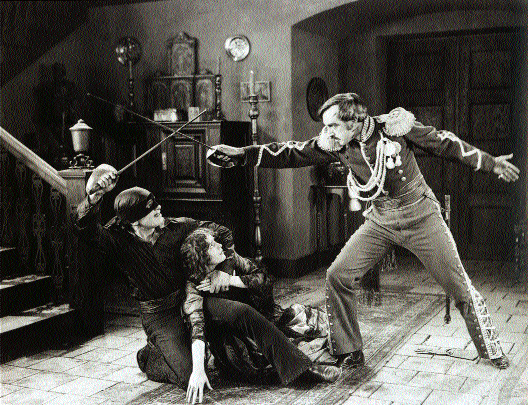
Hollywood takes over-Douglas Fairbanks in The Mark of Zorro (1920).
There have been many Irish expatriates, fighting the ‘good fight’, defending the oppressed in various parts of the world. So it is not surprising that one of them was a special hero, a new Robin Hood, who would be transformed into a legendary figure by modern writers and film makers. His name was William Lamport, later immortalised as Zorro. His story has been hidden for centuries in the Mexican Inquisition’s archives and rediscovered only in the last quarter of the last century. However, the few historians who were interested in him weren’t familiar with seventeenth-century Irish and European history and couldn’t verify his assertions or fully understand who he was.
Swordsman and spy
William Lamport was born in Wexford town in either 1611 (according to his brother) or 1615 (various other sources). He was the youngest of the four children of Richard Lamport and Anastasia Sutton, scion of a noble Catholic Old English family, who originally came to Ireland with Strongbow in the twelfth century and built a castle at Rosslare. The main branch of the family remained loyal to the crown of England, but circumstances forced some descendants of minor branches, in common with many Catholic Old English families, into rebellion against the English, such as William’s grandfather, Patrick. When, in the 1590s, Hugh O’Neill’s rebellion spread into Leinster, Patrick joined Viscount Mountgarret and was present at the battle of Kinsale.
William Lamport was educated by the Augustinians and Franciscans in Wexford and by the Jesuits in Dublin. In 1628 he went to London to study, but was compelled to leave because of his political opinions; he fell in with a gang of pirates; jumped ship in 1630, and fled to La Coruña, Spain, where he resumed his studies at St Patrick’s College and hispanicised his name to ‘Guillén Lombardo’. He got a lucky break in 1632 when he was recommended by the Marquis of Mancera, governor of La Coruña, to the Duke of Olivares (1587-1645), chief minister of Philip IV (1621-1665), and was summoned to the court of Spain.
Lamport, who had begun to acquire a reputation as a ladies’ man as well as a swordsman, in 1632-1633 studied both in S. Lorenzo (Escorial) and S. Isidro College (Madrid). As a captain in the Spanish army, he fought bravely at Nördlingen(1634) and Fuenterrabía (1638) against Swedish and French troops. Small and handsome, with red hair and flashing eyes, in 1634-1635 his portrait was painted both by Peter Paul Rubens (Timken Museum, San Diego, California) and Anton Van Dyck (Szépmüvészeti Museum, Budapest). Back in Madrid, in 1639 he supported Richard Nugent’s secret mission, to get money and soldiers for an Irish rebellion, an episode that, despite the documentary evidence in Simancas archive, is still little known by historians.
In 1640, Olivares sent him to Mexico to spy on the new viceroy, the Marquis of Villena, suspected of sympathy towards Portugal’s rebellion. Spanish rule was being challenged in many places and Mexico, too, was on the brink of ruin. The Inquisition was all-powerful and omnipresent and the inquisitors, as well as public functionaries, were notorious thieves; the oppressed classes were full of anger and a desire for revenge; the Church was divided into reform and conservative parties. In Mexico City Lamport led a double life. Engaged to a rich heiress, Antonia Turcios, (despite leaving behind in Spain his mistress Ana Cano y Leiva and a daugther, Teresa) he moved in the highest social circles, all the time collecting evidence against Villena and transmitting it to Olivares and to Juan Palafox, new bishop of Puebla, head of the reform party.
‘King of Mexico’
On 9 June 1642 Villena was arrested by Palafox, who replaced him as viceroy for a few months. During this period of disorder, Lamport conspired to overthrow Spanish rule, with the help of another former viceroy, Marquis Cadereyta, whose wife, it was said, was probably his mistress. On 26 October 1642, Lamport was arrested by the Inquisition, which accused him of conspiring against Spain to liberate Indians and black slaves, and also of being closely associated with Indian witch doctors and dabbling in astrology. He was accused of attempting to set himself up as king of an independent Mexico.
Lamport spent seven years in prison, becoming a leader of the prisoners, who were mostly Jews or converted Jews, imprisoned by the Inquisition, jealous of their wealth. Aided by the honest new viceroy, the Duke of Alba Aliste, and Palafox supporters, he managed to escape from prison on 26 December 1650, but he remained in Mexico City. He plastered the city walls at night with posters denouncing the crimes of the Inquisitors. Captured again after a few days, he was jailed for a further nine years and while in jail wrote many pamphlets in Spanish, attacking the Inquisition. He also wrote almost one thousand beautiful psalms in Latin, still unpublished. When Palafox, now in retirement in Spain, became too seriously ill to protect him any longer, he was condemned to burn at the stake in the auto de fe of 19 November 1659. Before the flames were lit, he managed to strangle himself with the rope used to tie him to the stake.
Posthumous fame
His fame survived his death, his deeds in support of the Indians and the underprivileged made him a hero in their eyes and of the Franciscan community of friars. In the people’s imagination he became the hero who struck in the darkness, challenged and ridiculed the Inquisition and wanted to proclaim himself king to free the Indians and black slaves. In his last will and testament Lamport proclaimed the hope that the time of God’s judgment would soon come and the certainty that the archbishop of Mexico City would be engulfed by the fires of hell.
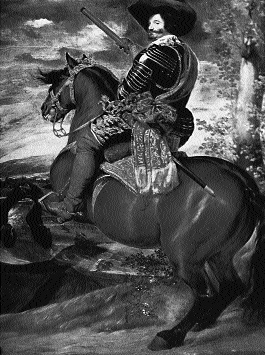
The Duke of Olivares, chief minister of Philip IV-in 1632 Lombardo was recommended to his service and summoned to the court at Madrid. (Museo del Prado, Madrid)
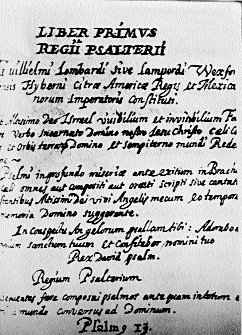
One of the hundreds of psalms written by Lombardo while in captivity
In 1666 the blacks and mulattos of Mexico City prepared a rebellion in the streets around the cathedral where the Irish fugitive had posted his placards. A drunkard called Bautista went about shouting that the archbishop of Mexico City was burning in hell, as Lamport had predicted. In the event the rebellion was aborted. Lamport’s fame spread as far as Nicaragua and in the following year a Franciscan from there, Fray Diego de la Cruz, in jail since 1661, was punished for having publicly praised him. The friar had been born in Dublin and expressed sentiments typical of Irish Franciscans in New Spain, all of them for too long compelled to hide and lie before the Inquisition.
The name of Lamport-Lombardo was no longer spoken openly, but his admirers continued to whisper it in secret, spurring the Indians to rebellion. On 19 December 1760 Antonio Péres, an Indian who had been taught by a discalced Franciscan friar near Puebla, founded a movement of ‘saintly’ believers, a syncretic mix of Christian ideas and native traditions: he drew inspiration from the figure of Lamport, writing manifestos to the authorities proclaiming that the archbishop of Mexico was already prey to the devil and that Péres’ right-hand man, Pascual, would receive from heaven the crown of ‘king of Mexico’.
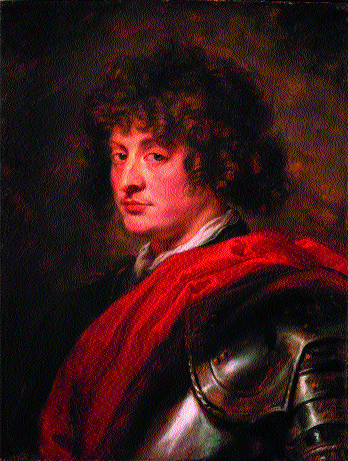
Peter Paul Rubens’ Portrait of a Young Captain, reputedly William Lamport, a.k.a. Guillén Lombardo, aka ‘Zorro’. (Putnam Foundation, Timken Museum of Art, San Diego)
Indian uprisings and messianic expectations continued throughout the eighteenth century and into the nineteenth: all were severely suppressed. During the night of 26 August 1796, a placard was posted to the gate of the cathedral in Mexico City. It was a paeon of freedom, inciting Mexicans to free themselves from monarchy and religion after the example of the French Revolution. Two Frenchmen, Captain Jean-Marie Murgier and a physician, Stephane Morel, were arrested on account of this conspiracy: both committed suicide in spectacular fashion as an extreme act of protest against the Inquisitors.
In 1810 Fr Miguel Hidalgo, son of a poor farmer and, according to the Inquisition, an avid reader of Rousseau, led a rebellion with the cry of ‘Long live Our Lady of Guadelupe, death to bad government and the Spaniards’. He was defeated and executed the following year. On Palm Sunday 1815, Inquisitor José Mariano Beristain died of a stroke while preaching a violent sermon against Hidalgo. Immediately a placard appeared claiming, just like Lamport’s, that this was a just judgment of God. In vain did the Inquisition seek the guilty party. Five years later it was abolished for ever: in the eyes of the people William Lamport had won.
Zorro is born
But the centuries long after-life of Lamport was not yet over. In 1872, Vicente Riva Palacio, a retired Mexican general, wrote a historical romance, in the style of Dumas’ The Three Musketeers, entitled Memorias de un Impostor. The hero of the book, Guillén Lombardo, leads a double life, plotting by night with a secret society to rebel against Spain and the Inquisition. The novel follows closely the story of Lamport inserting into the narrative original excerpts from his trial. The hero is a revolutionary yearning for freedom, but also a kind of Don Juan searching for true love. This Lombardo is a hero of the Enlightenment and of the Romantic period rolled into one. Being a Freemason, Riva Palacio gave to the Irishman a Masonic touch: his Lombardo is a victim of ecclesiastical obscurantism who saves himself from damnation by discovering the principle of life, the divine sparkle within all of us, that for Masons is symbolised by the letter ‘Z’, from the Semitic word ziza (shining), inscribed in a flaming star, symbol of the genius capable of raising men to noble and lofty endeavours.
In 1919 Johnston McCulley, a New York journalist and also a Freemason, reworked the tale, giving a new name to the hero: Diego de la Vega alias Zorro. He borrowed the alias el Zorro [the fox] from another Palacio character, Martin Garatuza, based on yet another real life seventeenth-century opponent of the Inquisition. McCully simplified the complicated plot of the Mexican writer to that of an action novel. He shifted the setting from seventeenth-century Mexico City to eighteenth/nineteenth-century Spanish California; he streamlined the dialogues and descriptions. But he understood the significance of the Masonic symbol and made it a keystone of all his hero’s actions. The hero with the double life strives to impress the ‘Z’ on all things. The reader might think that this is the initial of his name. But to the ‘initiated’ this is the symbol of Light triumphing over Darkness. If in Nathaniel Hawthorne’s The Scarlet Letter, the ‘A’ symbolises for the American reader shame and guilt, the bloody and shining ‘Z’ of Zorro symbolises the revenge of the oppressed and their victory over tyranny.
The myth of Zorro was born. By 1920, a year after McCulley’s novel was published, Hollywood took over. Douglas Fairbanks (also a Freemason incidentally) wrote the screenplay of, and starred in, The Mark of Zorro, which closely followed the basic plot, characters and dialogue of McCulley’s story. It made Fairbanks the number one box office star of 1920 and launched his image as a romantic hero in exotic costume adventures that became more elaborate with each new film. His Zorro characterisation spawned numerous sequels: Fairbanks played both father and son in the 1925 Don Q, the Son of Zorro; John Carroll starred in the 1937 Republic serial Zorro Rides Again; Tyrone Power remade the original in the 1940 The Mark of Zorro; Linda Sterling played a female Zorro in the 1944 serial Zorro’s Black Whip; Guy Williams starred in the popular 1958-59 Disney TV series (In 1992 the seventy-eight episodes were computer-colourised by Disney for international distribution and for the Disney Channel); George Hamilton starred in a spoof of the character in the 1981 Zorro the Gay Blade; Anthony Hopkins played the aging Zorro, who teaches Antonio Banderas to become the new Zorro, in the 1998 Mask of Zorro.
A ‘Winter King’
The Spaniards coined the phrase ‘winter king’ to describe the rebellious Duke of Braganza who proclaimed himself King João IV of Portugal in December 1640; like the straw puppets thrown into winter bonfires at folk festivals in celebration of the coming spring he was meant to last only a season.
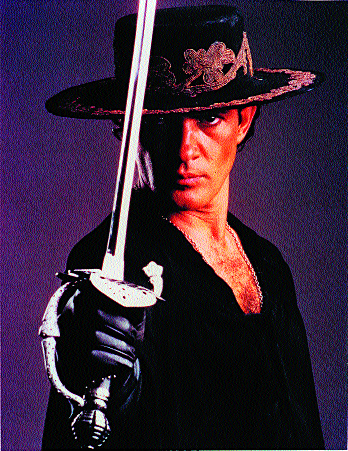
The latest Hollywood Zorro-Antonio Banderas in The Mask of Zorro (1998).
But rebels sometimes succeed and last more than a winter, like the Portuguese. William Lamport, however, does fit the metaphor of the ‘winter king’ even to the extent that he was burnt at the stake. He also resembles a ‘priest-king’ who gives his life that the world may continue. That’s why his image has been so popular: the descendants of the Aztecs, whose ancestors sacrificed sacred victims to the Sun, believed that the Irishman without home and honour was a brother in misfortune, one who would perhaps come to life again in the heavens, transformed, as the story goes, like the heroes of Teotihuacan into a ‘firebird’.
Fabio Troncarelli is a professor in the Department of Human Science at Università della Tuscia, Viterbo.
Further reading:
L. González Obregón , Rebeliones Indigenas y Precursores de la Independencia Méxicana en los Siglos XVI, XVII y XVIII (Paris, México 1908).
F. Troncarelli, La Spada e la Croce: Guillén Lombardo e l’Inquisizione in Messico (Roma 1999).
G. Ronan, ‘Zorro of Wexford’, in The Past, 22 (2000).
















